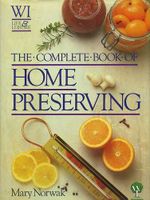Save 25% on ckbk Premium Membership with code FALLFLAVORS 🍁
Bottling
By Mary Norwak
Published 1978
Wines mature better in bulk so do not rush to bottle them. Leave them in gallon/4.5 litre jars, topped up to within 1½in/3.75cm of the cork, until the jar is needed, or the bottles are required for use. Dry wines will mature better than sweet, so assuming that maturing wines are dry when the time for bottling arrives, the decision has to be made as to whether they should be left dry, or should be sweetened to taste. It is at this stage that the need for balance should be borne in mind, for by just adding a quantity of sugar, without any other alteration, it is easy to finish up with a flat, uninteresting wine. Having decided to sweeten a wine, it is advisable to add a stabilizing tablet in order to prevent a secondary fermentation. To fortify the wine, add vodka or brandy before sweetening as the additional alcohol will immobilize the remaining yeast cells. Wine should always be racked before sweetening or fortification. Having sweetened and/or fortified the wine, it is ready for bottling. The bottles should be carefully washed, sterilized with a Campden or other solution, and drained. The corks used should be straight, not tapered, as close-grained as possible, and should have been soaked in a Campden solution with a little glycerine to keep them soft (for up to 12 hours). Bottles should be punted if possible, coloured for red wines, white for white or golden wines, and should be filled to about 1 in/2.5cm below the level of the cork. It is a good idea to have a small piece of string hanging over the lip of the bottle when the cork is driven home, so that when the string is withdrawn, it will allow the compressed air to escape. Wine should be carefully labelled with an attractive label with a carefully printed name. The label should be printed clearly with the main ingredient (or type of wine if it is a purpose wine), date, and whether sweet or dry.
Become a Premium Member to access this page
Unlimited, ad-free access to hundreds of the world’s best cookbooks
Over 160,000 recipes with thousands more added every month
Recommended by leading chefs and food writers
Powerful search filters to match your tastes
Create collections and add reviews or private notes to any recipe
Swipe to browse each cookbook from cover-to-cover
Manage your subscription via the My Membership page
Part of
Advertisement
Advertisement


